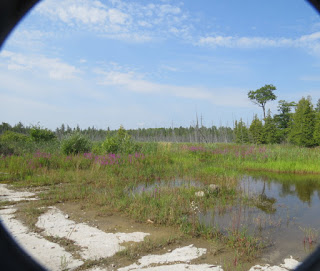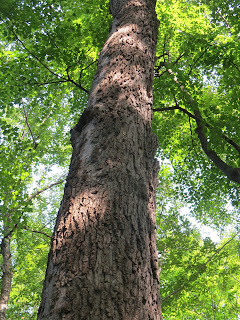Ever been on the Mississippi? Not THAT one! The OTHER one. It flows through Lanark County, Ontario to the Ottawa River, a LONG 700-mile (1,160 kms. for my Canuckian/European readers) river that carves a large valley as it makes its way to the St. Lawrence, at Montreal, Quebec.
When we locals say "Up the Valley", we mean the Ottawa (Outaouais, en français) River valley. Let's take a closer look.
Our regular readers will remember the Fun Guy, the Bug Man and now...the Fern Lady!
To begin:
We take a short drive on River Road (Renfrew County #1, a spectacular drive if you are out this way), to the west of Arnprior, Ontario.
One of the many responsibilities as a Director of the Mississippi Madawaska Land Trust Conservancy(MMLT) is to assess potential properties eligible for donation to us. As the name suggests, we operate within the Mississippi River and Madawaska River basins, and the territory between those two rivers, which retain quite a bit of wilderness, especially in the headwaters of both rivers.
The property shown above and below is not typical of the region. Note that the foreground of the top photo shows bare limestone rock and below note the dead trees over the rock in the background. I was hoping that this was a continuation of a habitat type that is very rare globally, but is found scattered in the glaciated territory between Lake Huron and the Ottawa River. These are alvars. Thin or no soil , wet in areas, and bone dry in others, these places host a different and unique community of plants and animals.
Although a well known alvar IS at the far end of this photo (the wet treeless part in the background), the area in the foreground was scraped bare by machinery. Oh well, maybe in the future someone will donate an alvar or two to the MMLT.
A few days later in August, Jan (above) and I made our annual trek to the Hugli Blueberry Ranch near Pembroke, Ontario. The plant rows are fruit-heavy Highbush Blueberry varieties. We pick about 50 kgs. and store them in our chest freezer for smoothies, desserts, cereal and crunchy granola.
Highbush blueberries are larger and easier to grow and gather than our local lowbush varieties. Highbush blueberries grow wild in the Carolinas in the USA.
After the heavy labour of blueberry picking, we stop in Beachburg for a cooling drink and dessert at Simple Things: https://whitewatercandle.ca/contact/Yes.they make those candles too:)
A few days later, the Mississippi Madawaska Land Trust held an event at one of our properties: Rose Hill Nature Reserve. Some of our properties, including this one, are administered by MMLT through a 999-year Conservation Agreement, which creates an easement. The owner retains ownership and limited use within the parameters of the agreement. This works to benefit our natural wealth, as nature is conserved under these agreements, and owners often take on a management and stewardship role within the organization. Bethany Armstong, comfortably seated at the entrance, is a Rose Hill owner, AND a Director of MMLT. Note the sign for Rose Hill at the centre top of the photograph.
The story of the several properties that make up Rose Hill is here:
https://mmlt.ca/protecting-nature/our-protected-properties/rose-hill-nature-reserve/
Above, MMLT Director Bethany Armstrong greets us at the entry to Rose Hill Nature Reserve. It is thanks to land donation by Bethany and her sister that started this very large reserve. Bethany is also the Director responsible for Rose Hill.
Our intrepid group (below) prepares for our hike along one of Rose Hill's trails. Individuals are encouraged to visit. Groups need to fill out an access form available on the linked page above. Our properties are first and foremost nature reserves. The basic rules apply: stay on the trails, take only photos, leave only footprints. Dogs are permitted on some reserves. Do read the rules available on the website before setting out.
Loyal blog followers will recall previous mushroom identification rules: a photo does not usually suffice! You need to analyze your finds in a laboratory after collection in a basket designed to maintain the integrity of your 'shrooms. These photos, once again prove this point. The young orange mushrooms (above), seen only from the top, have few necessary bits of information required for identification.These could be Hygrophorus (large genus), common mushrooms in coniferous forests.
See my blog on this topic here:
https://opinicon.wordpress.com/2016/10/09/fabulous-fall-fungi-with-a-fun-guy/
There are many small orange mushrooms. For identification, we need to see the underneath of the cap and we need to see spores. Also, it is necessary to do several other laboratory tests to ascertain the family. To get down to a species is often not possible.
Are these Turkey Tails (below) and and old, ratty Lactarius or Russula (above)? The problems of IDing 'shrooms prevails. I cannot tell from a photo. If you want to learn about mushrooms/fungi or you THINK you know the edible fungi, please click the link above and register for one of Richard Aaron's courses at Queen's University Biological Station.
Even Turkey Tails, Trametes versicolor, are not immediately identifiable, as there is another bracket fungus, False Turkey Tails or Stereum ostrea, which looks very similar. You have to look UNDERNEATH the fungus. Turkey Tails are creamy white underneath, with pores. Stereum ostrea has a smooth underside, making it a crust fungus, while Trametes versicolor is a polypore (literally meaning that there are lots of pores on the under surface).
Adding further to the botanists' challenges, the Frontenac Axis is home to many species of rock-hugging lichens and mosses, as seen below. There are few experts studying these important pioneering plants of the Canadian Shield.
The moss on the left side of the above photo is Polytrichum commune or Common Hair Cap Moss. This common moss, along with the peat mosses, was used extensively to stuff pillows and make small brooms. At least one Indigenous Nation that I know of, used mosses of this type for diapers. The photo was sent to a retired Canadian Nature Museum moss and liverwort expert for identification. She confirmed the Polytrichum commune. I thought that the middle clump was a liverwort. She confirmed this. Finally, the reason I was so confounded by the clump of moss on the photo's right side is that there are 3 moss species!
My thanks to Cathy Keddy who graciously identified many of the plants on and around this floating peat mat on Fufflemucker Pond at Rose Hill. Note that she has printed the names right on the photo. Just seeing "Fufflemucker Pond" on the map made it essential that I visit.
Rock Polypody
Several mushrooms were seen, including Amanita (left), also known as "Destroying Angel".
Club moss, above.
Above, at Rose Hill Nature Reserve, MMLT's past president, Howard Clifford, congratulates John Hatton. John's wife, Patricia Hatton has ensured that her promise to her late husband, Robert Brodey, will be fulfilled and the place they had enjoyed so much will be preserved so that others will learn to love and respect nature as he did. Brodey's legacy added 258 acres to the original acreage donated by Bethany and her sister, Charlene.
Lis (left) and Maureen (MFNC Trip Organizer) discuss ferns. Or is it my new haircut? Ok, it was ferns for sure!
Lady Fern (above) Athyrium filix-femina --a name most befitting a Lady! New York Fern, Thelypteris novaboracensis below. I recall one of my favourite naturalists locally, Harry Thomson, saying to me that you always knew a Lady Fern due to its lacy appearance. It is similar to New York Fern -except the latter does not have toothed margins on the pinnules. It is the toothed margins that give Lady Fern its lacy appearance.
Hay-scented Fern, Dennstaedtia punctilobula, above. One of our field trips in the Ottawa Valley was at a nearby farm that had thousands of Hay-scented ferns growing together. This is typical of this species. If present, it grows large numbers over a great area.
Another rarity, Purple-stemmed Cliffbrake, Pellaea atropurpurea, below.
A close relative to Purple-stemmed Cliffbrake is Smooth Cliffbrake, Pellaea glabella (below). Both species have purple stems. Differentiating the two is a challenge, as the main difference is that the above species has a hairy stipe and rachis. That does sound risqué, doesn't it?
This edition ends back home in Arnprior, at Gillies Grove, a Nature Conservancy of Canada protected site where there is one of the best examples of Ottawa Valley old growth forest, including Ontario's tallest tree, a 157 foot White Pine.

Northern Tooth Fungus,Climacodon septentrionale, on its favourite tree, the Sugar Maple (above). These fungi are very large, often half a metre in height and width, which is about the size of this specimen.

Canada Goldenrod, Solidago canadensis, in Gillies Grove. We see a lot of this stunningly beautiful native flower, in all of its golden glory in the last half of our summers. In many parts of the world, and in my garden, it is a late-blooming ornamental that attracts myriad pollinators.
There is confusion about this plant. A long held myth is that this plant causes most hay fever. That distinction goes to another native plant that loves to invade fields, roadsides and vacant lots: Ragweed, Ambrosia artemisiifolia. It is a distant cousin of the Goldenrods. Unlike Goldenrods, it's flowers are green and inconspicuous. Most people do not notice it, and when they do, they recognize that it is unobtrusive, homely and common. So next time you sneeze, remember, it isn't this lovely flower shown above.
A much rarer Hairy Goldenrod, Solidago hispida, found at Constance Bay, Ontario's Torbolton Forest, also in August 2017. The Torbolton Forest was mostly sand dunes, until it was forested. The section I visited was returned to its natural state, and some of the rare plants, like this one, were returning. There are 13 Goldenrod species in our area, and dozens more in North America.

Seaside Goldenrod, Solidago sempervirens (sempervirens means "always alive". It is well named as it beautifies wild coastal beaches along the Atlantic shore through most of the winter. Here is an example I found at the Assateague National Seashore in Virginia.
One of the old growth giants-a Sugar Maple, Acer saccharum, just a few blocks from our Arnprior, Ontario main street.
In the next edition, we join the entertaining Michael Runtz on a hike at High Lonesome Nature Reserve,

































No comments:
Post a Comment
Help with "Comments"
1) Click on "Comments" at the end of the blog entry that you wish to comment on.
2) Type your comment in the field provided.
3) Under your comment choose "Name/URL". Type your name (first and/or last names) in the box provided. Choosing "Name/URL" will ensure that you do not need to "register" before leaving a comment.
4) Click "Preview" to see how your comment will look on the site if you wish, otherwise skip to step 5.
5) Click "Publish" to submit your comment.
Please note that all comments are moderated so I will review them before they are published.
I look forward to receiving your comments.